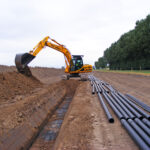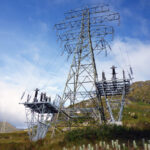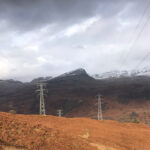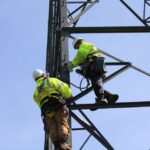Skye Reinforcement
Project info

The scope of Energyline’s engagement included conductor selection studies, foundation evaluation studies, on site surveys and inspections, load and strength studies and construction appraisal with respect to the tower and foundation strengthening requirements.
Principal activities
Support verticality and span geometry surveys were carried out to identify any potential risks and verify LiDAR data (supplied by SSEN). The selection of the supports was with reference to previous FES studies i.e. where geotechnical misalignments and ground stability issues were identified.
Full non-outage climbing surveys were undertaken to assess the condition of a sample of 30 supports. The output of this activity was a detailed bar-by-bar condition report for each support, which provided a representative sample for the overall condition of the route and provide a basis for the construction assessments.
Engineering walkthrough survey for: verification of individual support details and site features, verification of the in-span and site wide features that may affect design, construction and future maintenance, Assessment of general land quality in respect of access and working area conditions, verification of any third-party details. In general terms the survey provided the necessary information for the construction assessments and risk assessments.
Construction, access and programme appraisals were conducted to confirm the impact of the proposed reutilisation options, their corresponding proposed strengthening requirements and system access implications.
Conductor selection study including 8 no. conductor options both of conventional and HTLS types. The selection was based initially on ampacity followed by mechanical utilisations, in-span internal and external clearance study, and finally at-tower clearances. These assessments were also conducted in a similar vein for the OPGW.
Support and Foundation load and strength including preparation of 79 No. individual PLS Tower models for all variants of support including hillside extensions. Load and strength associated with feasible conductor system options.
Foundation evaluation studies were undertaken in two phases; the first, a non-intrusive desk study, visual survey and report. The second phase included:
- Ground Investigations and Intrusive Foundation Inspections
- Laboratory testing and reporting
- Risk Assessment
- Review of Foundation evaluation study and need for foundation refurbishment/ upgrade designs.
As well as reporting, a range of drawings were produced for the purposes of undertaking the studies and as output project information.
None of the above work was sub-contracted
Project gallery
- Cable Design System
Contact us to discuss your next project
Contact usServices
Contact us
North Yorkshire HG3 3TB
Tel: 01423 799950
Terms & ConditionsPrivacy Policy



ISO 9001 ISO 14001 ISO 45001





